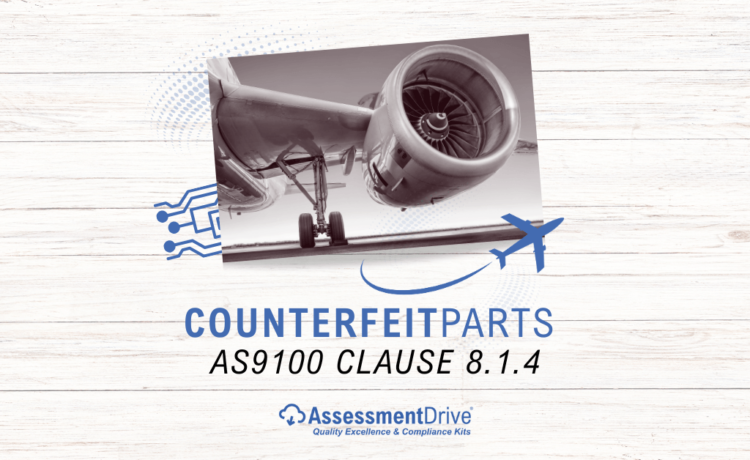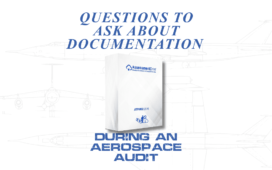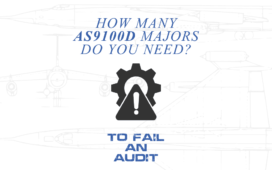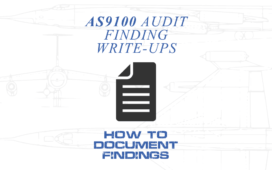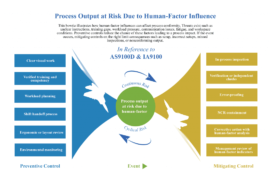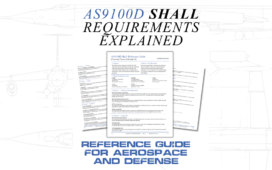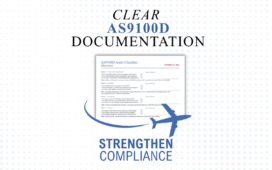
Introduction
Counterfeit parts are a growing threat in aerospace and defense. AS9100 Clause 8.1.4 was introduced to address this critical risk with structured prevention methods. This guide breaks down what the clause requires, how to comply, and how to prepare your Quality Management System (QMS) for audit success.
What Is AS9100 Clause 8.1.4?
Clause 8.1.4 of AS9100D mandates that organizations establish processes to prevent the use of counterfeit or suspect counterfeit parts. This includes both the identification and control of components that may compromise product safety, reliability, or traceability.
What Counts as a Counterfeit Part?
A counterfeit part may include:
- Unauthorized copies or substitutes
- Parts misrepresented by age, certification, or origin
- Recycled or used parts sold as new
- Components with altered markings or falsified documentation

Key Requirements of Clause 8.1.4
To comply with AS9100 Clause 8.1.4, organizations must:
- Develop a documented process to prevent counterfeit parts.
- Use trusted and approved suppliers only — ideally those with AS9120 or similar certification.
- Implement traceability controls such as serialization, barcoding, or lot tracking.
- Verify product authenticity through source verification, testing, or inspection.
- Train employees on recognizing counterfeit indicators.
- Report and quarantine any suspect parts per a formal process.
- Maintain records of validation, inspections, and actions taken.
Example: Counterfeit Part Prevention Procedure (Summary)
Title: Counterfeit Part Prevention Procedure
Doc Ref: QMS-8.1.4-001
Sections:
- Scope and Purpose
- Roles and Responsibilities (Procurement, QA, Inspection)
- Approved Supplier Criteria
- Incoming Inspection Checklist
- Quarantine and Reporting Flow
- Training Log and Annual Review Requirements
Recommended Tools and Documentation
To strengthen compliance, implement the following:
| Document | Purpose |
|---|---|
| Supplier Verification Form | Validates certifications, traceability, and authorization |
| Counterfeit Reporting Log | Tracks suspected parts and investigation outcomes |
| Training Sign-In Sheet | Confirms annual training is documented |
| Inspection Checklists | Guides visual and physical inspections of high-risk components |
| Material Certificate Tracker | Validates C of C and traceability |
Integration with Risk-Based Thinking (Clause 6.1)
Counterfeit part risks should be included in your risk management activities. During planning, ask:
- Is this supplier high-risk?
- Have we verified their certification and traceability records?
- Do we have alternate sources in case of rejection?
Use heatmaps or risk assessment tools to visually capture this.
Audit Readiness Tips
- Ensure your counterfeit part prevention process is documented and accessible.
- Be able to demonstrate training records.
- Keep quarantine logs, even if no incidents have occurred.
- Be prepared to show how you evaluate and re-evaluate suppliers.

New Requirements in AS9100 Clause 8.1.4 – Counterfeit Part Prevention
AS9100 Clause 8.1.4 has been enhanced to strengthen how organizations prevent the use of counterfeit or suspect counterfeit parts while the release of IA9100 is expected in late 2026. While the previous version offered general guidance through an informative note, the updated clause now introduces enforceable requirements. These changes demand documented processes, role-specific training, and defined control measures such as traceability, verification, and segregation. This section outlines the key differences between the original and enhanced clause, helping quality managers and aerospace suppliers understand what must now be implemented to remain compliant and audit-ready.
| Area | AS9100D (Existing Clause 8.1.4) | Enhanced Clause 8.1.4 (New) | What Changed |
|---|---|---|---|
| Introductory Requirement | General obligation to “plan, implement, and control” counterfeit part prevention processes. | Same wording retained. | No change. Intro remains consistent. |
| Structure | Listed as a NOTE with bullet points (non-mandatory guidance). | Converted into mandatory process requirements with lettered subclauses (a–g). | Major shift: From guidance to enforceable requirements. |
| Training | “Training of appropriate persons in the awareness and prevention…” (general statement) | Specifies who should be trained — e.g., procurement, receiving, shipping, material control. | More prescriptive — roles are now identified. |
| Quarantine and Reporting | “Quarantine and reporting of suspect or detected counterfeit parts.” | Expanded to “segregation, containment, and reporting…” | Added specificity — “segregation” and “containment” are now called out. |
| Formatting and Language | Informative style (suggestions with “should”) | Directive style (requirements with “shall include, as applicable”) | Shift from recommendation to requirement. |
| Applicability | Was optional/contextual, in a NOTE | Explicitly requires evaluation of applicability (“shall include, as applicable”) | Now subject to audit and must be justified if not implemented. |
What This Means for Your QMS
1. Noncompliance Risk Increased
Previously, the NOTE meant organizations could loosely address these topics. Now, each element (a–g) is potentially auditable and must be documented or justified.
2. Training Must Be Documented and Role-Specific
You must now clearly show which roles are trained (procurement, receiving, etc.) and have a log or record of that training.
3. Counterfeit Part Handling Requires a Stronger Chain of Control
You’re expected to not only quarantine counterfeit parts, but also segregate and contain them physically and procedurally. This implies secure storage, labeling, and controlled access.
4. “As Applicable” Still Allows Flexibility — But With Evidence
You can still exclude some items (like testing methodologies or obsolescence programs) if not applicable, but you must document your rationale.
AS9100 Clause 8.1.4 is more than a checkbox — it’s a defense line against real-world threats to quality and safety. Proactively addressing counterfeit risks not only supports compliance but protects your brand, your customers, and your contracts.
FAQ
Q: Is the updated Clause 8.1.4 mandatory for all aerospace suppliers?
A: Yes. While the older clause used a NOTE format (suggesting guidance), the updated version uses mandatory language. Organizations are now expected to implement applicable processes and justify any exclusions.
Q: What kind of documentation is needed to show compliance?
A: At a minimum, you should maintain:
- A documented counterfeit part prevention procedure
- Supplier verification records
- Evidence of traceability
- Training logs for relevant staff
- Quarantine logs or reports for any detected/suspected parts
Q: How does Clause 8.1.4 relate to procurement and supply chain management?
A: It directly affects purchasing controls. You must source parts only from original manufacturers, authorized distributors, or validated suppliers. Supplier approvals must be documented and traceability ensured.
Q: What does “as applicable” mean in the clause?
A: It means that organizations must evaluate whether each requirement (a–g) is relevant to their operations. If any are not implemented, justification should be documented. For example, if you only use commercial off-the-shelf parts, testing methodologies might not apply.
Q: Are training and awareness required for all employees?
A: No. Only roles involved in procurement, receiving, inspection, and material handling need to be trained—but their training must include specific content on counterfeit prevention and be formally documented.
Q: What’s the difference between quarantine and segregation in this context?
A: Segregation refers to the physical separation of suspect parts from conforming materials, while quarantine includes tagging, documentation, and ensuring no unauthorized access or use occurs.
Q: What tools can help identify counterfeit parts?
A: Tools may include:
- Visual inspection checklists
- Certificate of Conformance (C of C) validation
- Serial number tracking systems
- Third-party authentication services
- Obsolescence monitoring databases (e.g., ERAI, GIDEP)
Q: What happens if a counterfeit part is found?
A: You must immediately segregate it, notify internal quality leadership, and report it per your procedure. External reporting may be required (e.g., to customers, regulators, or organizations like GIDEP).
Q: Do I need to perform testing on every part to detect counterfeits?
A: No, not necessarily. Testing is one possible control, but if you rely on approved suppliers with full traceability, other measures (like source verification and documentation review) may suffice.

Ronnie Lee Roberts II has worked in the Department of Defense (DoD) quality space since 2017, supporting programs at Patuxent River and Webster Field (NAWCAD/NAVAIR). He has worked as a certified AS9100:2016 Rev D Lead Auditor (2022-2025), ISO/IEC 20000-1:2018 Lead Auditor (TPECS [2023]), and a Certified CMMI® Associate (2025) with experience supporting CMMI-DEV Level 3 environments. His expertise spans technical writing, document control, CAD design, logistics management, and quality control. Ronnie specializes in inspecting to specification, ensuring contract compliance, and preparing teams for success in high-stakes, audit-ready environments.

